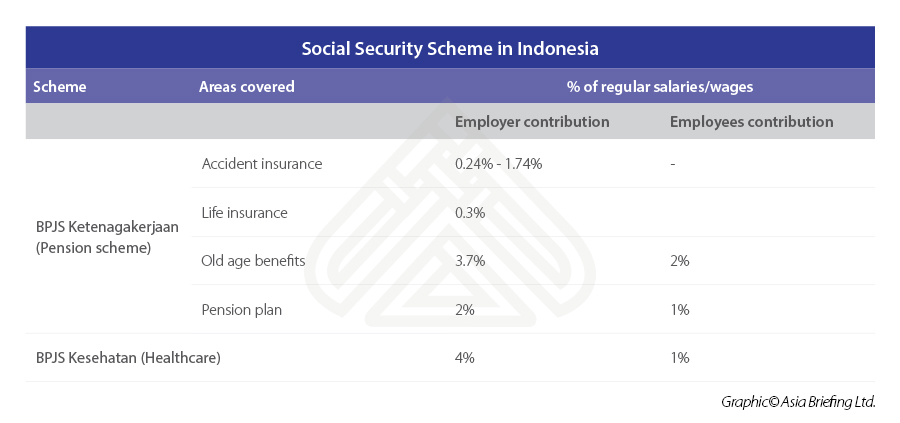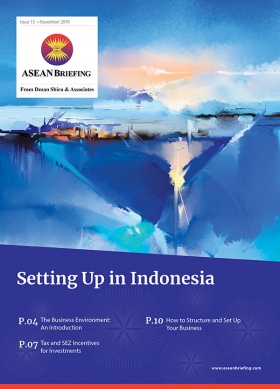Indonesia Increases Social Security Premium for 2020
- Indonesia’s social security programs are run by two organizations – the Social Security Administrator for Health (BPJS Kesehatan) for healthcare and the Workers Social Security (BPJS Ketenagakerjaan) for pensions.
- The government raised the taxable wage cap for the national pension plan program from March 2020 as well as the premiums for the universal healthcare program from July 2020.
- Since its inception, the healthcare program has become the biggest in the world with more than 185 million participants.
Indonesia’s social security programs are run by two organizations – the Social Security Administrator for Health (BPJS Kesehatan) for healthcare and the Workers Social Security (BPJS Ketenagakerjaan) for pensions.
The government raised the taxable wage cap for the national pension plan program from March 2020 as well as the premiums for the universal healthcare program from July 2020.
The government launched its ambitious universal healthcare and pension programs in 2014. Since its inception, the healthcare program has become the biggest in the world with more than 185 million participants. Registered Indonesians and expatriates are eligible for free health services ranging from dental care to medicines to physiotherapy. Further, patients are also eligible for free emergency and chronic care, in addition to organ transplants.Who is eligible?
The government has made it mandatory for all Indonesian citizens and expatriates to participate in the social security programs. Expat employees must also enroll their families in the programs.
How to determine healthcare class facilities
The BPJS healthcare system is divided into three classes. This does not determine the level of treatment a patient receives, but it does determine the type of hospital room they will be given. Hospital rooms in Indonesia come with varying levels of comfort and size.
Class I patients are provided rooms with two or three other patients while class II patients have to share with three to six others. Class III patients will have to share with 10 or more patients.
How to calculate the healthcare premiums for employees?
The premium for employees is calculated as five percent of the monthly salary, with a salary cap of 12 million rupiah (US$839).
In the private sector, the employer must pay four percent and the employee the remaining one percent. For civil servants, the government contributes to three percent while the employee contributes two percent.In addition to the employee, the premium also covers their spouse and up to three dependent children up to the age of 21.
Employees earning less than 4 million rupiah (US$279) per month are eligible to receive Class I room facilities at the hospitals. Employees earning lower than this can receive Class II and III room facilities.
How to calculate the healthcare premiums for non-employees?
The new premiums for individuals that are classed as non-employees/self-employed /non-formal workers is as follows:
- Class I – 150,000 rupiah (US$10.21) per person, per month;
- Class II – 100,000 rupiah (US$6.80) per person, per month; and
- Class III – 25,500 rupiah (US$1.74) per person, per month (for this specific class, the government will top up an additional 16,500 rupiah (US$1.12) of the total amount, per person, per month)
How to calculate the pension premium for employees?
The pension program covers the following:
- Work compensation – provides protection for accidents occurring during or as a result of work;
- Old age benefits – provides protection for participants that are in retirement, laid off;
- Pension benefits – provides guaranteed income in retirement; and
- Life insurance – upon the death of the participant, their heirs can claim the benefits.
Based on Government Regulation No. 45 of 2015, the required rate of contribution to the pension fund is three percent of the employee’s monthly wages. This is divided between the employer (two percent) and the employee (one percent).
Furthermore, there is a maximum wage base for these deductions. As of March 2020, this will be raised to 8,939,700 rupiah (US$625). and increase from 8,512,400 rupiah (US$593) in 2019.
The government calculates the maximum wage base through the following formula:
Highest wage limit in 2019 x (1+Gross domestic population growth rate in 2019)
Therefore:
8,512,400 rupiah (US$593) x (1+5.02/100) = 8,939,700 rupiah (US$625)
As of 2018, the number of participants in the pension program has reached 11.5 million people. Only medium and large companies are obligated to join the program whereas small and micro enterprises can participate on a voluntary basis.
Some 90 percent of workers in large companies and 60 percent in medium-sized companies are already covered by the pension program.
The social security system can be summarized through the table below:
The article was first published on February 28, 2020. It was last updated on August 8, 2020.
About Us
ASEAN Briefing is produced by Dezan Shira & Associates. The firm assists foreign investors throughout Asia and maintains offices throughout ASEAN, including in Singapore, Hanoi, Ho Chi Minh City and Jakarta. Please contact us at asia@dezshira.com or visit our website at www.dezshira.com
- Previous Article Thailand Allows Entry for Selected International Travelers
- Next Article Vietnam’s Entry Procedures for Foreign Employees amid the Pandemic









